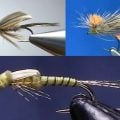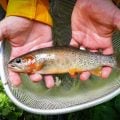How to Tie the Great Blue Heron – Soft Hackle Streamer
Producer: tightlinevideo
I call this fly the Great Blue Heron, even though it’s much more like a Jack Gartside’s Soft-hackle Streamer than it is a Nick Lambrou Heron.
The fly starts with a Pro Sportfisher clear micro tube. Slip the tube onto a tube fly mandrel and make sure it’s seated very well, so as not to just simply spin around the mandrel. I like to add a small drop of super glue to the midpoint of the tube before wrapping any thread.
For thread, I’m going to use UTC 140 Denier in black. I’ll load it onto a bobbin with an extra-long nozzle for easier navigation around the long mandrel. Get the thread started in the super glue and, after taking a few wraps rearward, snip off the excess tag. The adhesive works wonders at stopping the thread from slipping on the tube. Establish a nice base with your tying thread then leave it at the midpoint of the tube.
A two card-width segment of silver sparkle braid is used to cover the rear half or so of the fly. Lay one end of the braid against the near side of the tube at the location of your tying thread and start taking tight wraps rearward to secure it. Bind it down really well, all the way to the stop at the end of the tube, then advance your tying thread back to about the midpoint.
Get hold of the braid and start making touching wraps with it up the tube. When you reach your tying thread, use it to anchor the material then snip the excess off close. Take a few more tight thread wraps to make sure the end is bound down really well. A small drop of super glue, followed by tight thread wraps, will ensure nothing can come undone.
For some flashy movement, snip two strands of pearl Flashabou free from the hank and find their midpoint. Fold the midpoint around your tying thread then bring it up and anchor it on top of the tube, to form four rearward-pointing strands.
Pearl gray marabou is used to form the bulk of the fly’s body. White and tan also look really good. Get hold of one nicely formed feather and strip off the lower, matted or misshapen fibers from both sides of the stem. Isolate the very tip of the feather by pulling down on the lower fibers. Snip that isolated tip off then anchor the stem and the swept-back fibers with tight wraps of tying thread.
Using your favorite pair of hackle pliers, get hold of the feather’s stem, pull it up to vertical, sweep the fibers rearward and start taking touching wraps up the tube with the feather, preening the fibers back as you go. When you reach bare stem, use wraps of tying thread to firmly anchor it to the tube, then snip the excess off close. Take a few more thread wraps to make sure the end is bound down really well. Here, too, I like to apply a small drop of super glue to the bare thread, then take wraps through it to set the adhesive so nothing can come unraveled.
Repeat the same marabou feather-prep process as you did before. If you have it, a slightly darker shade of marabou feather than the last, looks really nice. Snip off the feather’s tip and anchor it in the same manner as you did the previous, then wrap it as before. Here also, some super glue and thread wraps can be used for insurance.
One or two mallard flank feathers, that have been dyed dark blue, are used to add a little contrast to the front of the fly. The length of the fibers is kind of important, so begin stripping off the fuzzy stuff from the lower, thicker part of the stem. Measure the fibers against the marabou. I like them to extend nearly halfway down the marabou fibers, and here they’re just a little bit long, so I strip off a few more from both sides of the stem. Now the mallard looks about right.
Get hold of the feather’s very tip and preen the lower fibers down, like you did with the marabou. Then, snip off the tip and anchor the feather just as you’ve been doing. Once again, get hold of the feather’s stem and start taking wraps with it, preening the fibers rearward as you go. Anchor the stem then snip the excess off close. I like this dark blue accent to be minimal but you can certainly add another dark blue feather if you prefer.
Pick up your bodkin and preen out both the mallard and the marabou fibers to get them spread as best you can around the tube. I like to use a large whip finish tool to whip finish here so as not to bump into the long mandrel too much. After completing a 5-6 turn, back to front whip finish, seat the knot well and snip your tying thread free.
Now, apply an ample drop of super glue to coat all the exposed thread wraps. At this point, you could finish the fly by melting the end of the tube but I prefer to add a large, black Ultra Sonic Disc before doing so as I like the look, the vented design and just that extra little bit of weight at the front of the fly. Make sure the disc is set well in the super glue before letting go. Move the tube up on the mandrel so the end hangs off. Then, using a lighter or here, a cauterizing tool, melt the end of the plastic tubing back onto the front of the disc. Slide the tube back onto the mandrel to make sure the hole in the end of the tube stays open.
You can then trim the Flashabou off so it’s just a little bit longer than the tips of the marabou. To rig the fly, something like an Owner Mosquito hook in size 4 is a good choice. With a small length of hook holder tubing added to the back of the fly, the hook should land about like this, just shy of the marabou tips.
As you can see here, the Great Blue Heron is a fair bit bigger than a Little Blue Heron. I can’t wait for some warmer weather and ice-free water to give them both a swing.
How to Tie the Grannom Caddis Pupa
How to Tie the Grenadier - Soft Hackle, Wet Fly Trout Pattern











